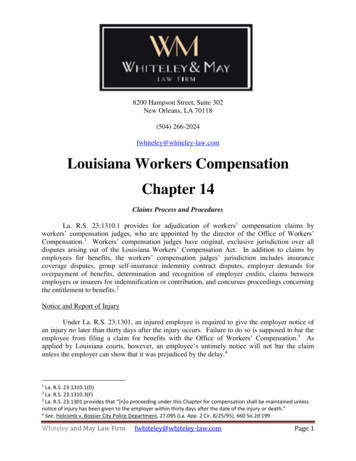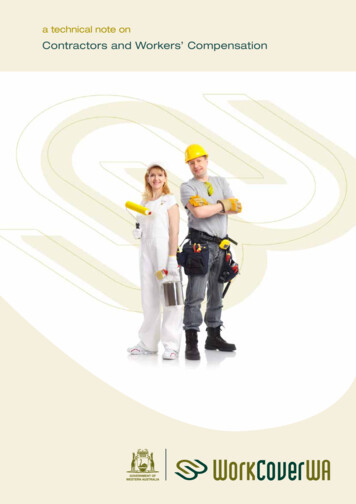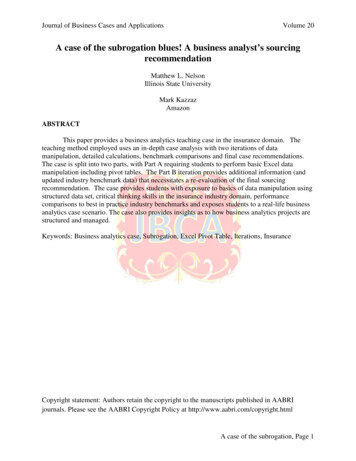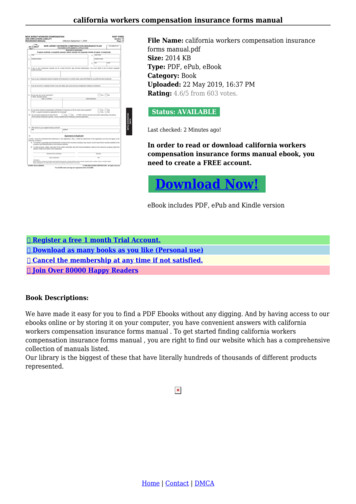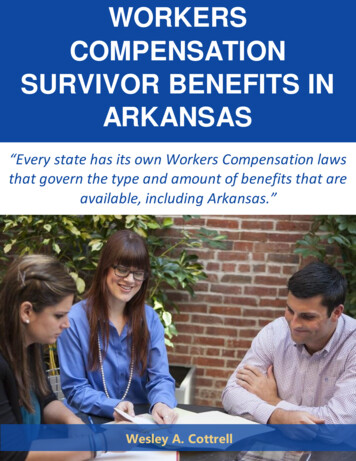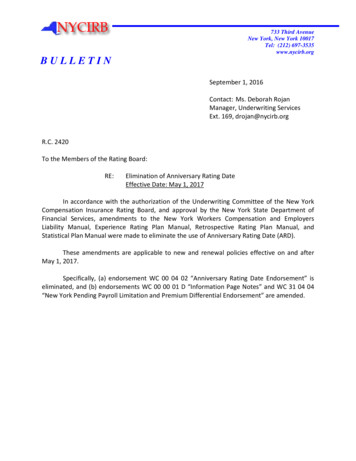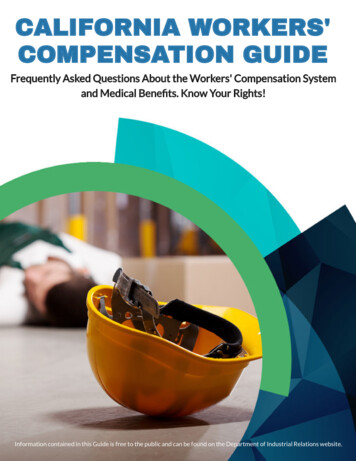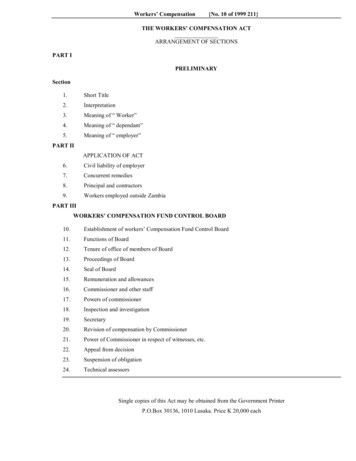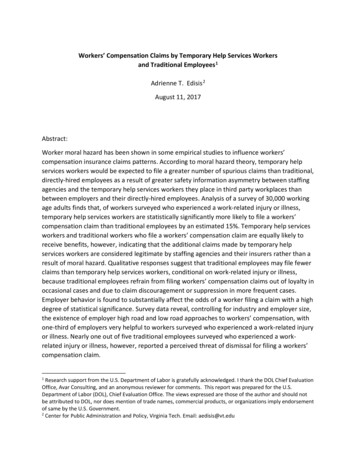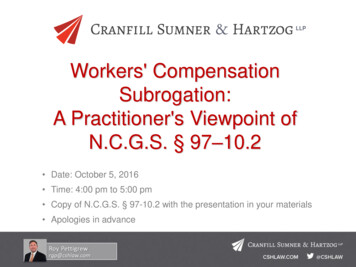
Transcription
Workers' CompensationSubrogation:A Practitioner's Viewpoint ofN.C.G.S. § 97–10.2 Date: October 5, 2016 Time: 4:00 pm to 5:00 pm Copy of N.C.G.S. § 97-10.2 with the presentation in your materials Apologies in advance
Overview of the Presentation Defining “Subrogation.” Overview of N.C.G.S. § 97-10.2. How N.C.G.S. § 97-10.2 interfaces with workers’ compensationclaims and bodily injury claims. Practice pointers and avoiding pitfalls in subrogation claims.(“SUBRO TIPS”) Role of “employer negligence.” How to value a workers’ compensation lien. UM/UIM implications. Recent case law re: N.C.G.S. § 97-10.2.
Defining “Subrogation”“The right of one who has paid an obligation whichanother should have paid to be indemnified by theother.” Source? Black’s Law Dictionary“The substitution of one person for another; especially,the legal doctrine of substituting one creditor foranother.” Source? The American Heritage Dictionary of the EnglishLanguage
What is this really about For the defense: Recovering the workers’ compensationbenefits you pay out because the accident occurredunder circumstances where someone else is at fault.That someone else the “third party”For the plaintiff: Obtaining additional compensation forinjuries sustained, and limiting the requirement toreimburse your employer the workers’ compensationbenefits paid to and on your behalf.
Other subrogation scenarios Not just workers’ compensation subrogation. Can occur in any scenario where one entity pays a claim that shouldhave been paid by another “third party” or their carrier. For example: Defective or defectively installed hot water heaterfloods a home. Homeowner files a claim with their carrier forproperty damage. If the claim is paid, the insured/carrier can fileagainst the manufacturer/installer of the hot water heater to seekreimbursement for the loss. There is common law subrogation. However, workers’ compensation claim subrogation is exclusivelycontrolled by N.C.G.S. § 97-10.2.
Look to N.C.G.S. § 97-10.2 The North Carolina Workers’ Compensation Act (“the Act”)does not directly define “subrogation.” Unlike more common terms like “employee”, etc. It handles the concept of “subrogation” in a statutory manner. In other words, you always start with the express language ofthe Act to determine your “rights”. Reinforced by mandatory language at N.C.G.S. § 97-10.2(a) “shall be as set forth in this section.” Consider some other legal concepts to put this into context.
Contractual Subrogation Oftentimes insurance contracts will confer certainrights of recovery. For example policy holder assignstheir rights to permit the carrier to pursue a liablethird-party for reimbursement. Sometimes an issue where the insured does not wantto cooperate in pursuing the claim. Examples: a temporary staffing agency doesn’t want to implicateone of their best clients; a group of businesses that work together in theconstruction trades are dependent upon one another fortheir livelihood
Contractual Subrogation (cont.) But, recognize that if the employer/insured does notcooperate that can frustrate the litigation. (Loss of keywitnesses and testimony) Can, at times, create a conflict between the carrier and theemployer. For carriers: Should be a factor to consider for underwritingpurposes. Similar problems arise if the injured employee or theirattorney do not want to pursue the third party. Happening more with recent tort reform, especially “billedversus paid”
Indemnification Agreements Contracts of “indemnity” can also give rise to a right or claim ofreimbursement (or attempt to limit liability). “Indemnify” defined as: “To reimburse (another) for a loss sufferedbecause of a third party’s or one’s own act or default.” Common theme – “third party” Frequently seen in construction contracts and some contracts forgoods or services, BUT Some contracts like these have been held void as violating publicpolicy. See N.C.G.S. § 22B-1. Reason: To discourage entities to try and contract out of their ownnegligence. Discussed at N.C.G.S. § 97-10.2(e) as well.
Compare Equitable Subrogation An insurer asserting a conventional subrogation claim rightfully paida claim for its insured, in the first instance, under its policy, butcontends that another party is primarily liable for the loss. This is why N.C.G.S.se e By contrast, an insurer asserting an equitable subrogation claim didnot owe the claim, in the first instance; it was owed by anotherentity. For example: Health insurance carrier mistakenly pays medical billsfor someone that was not their insured, and then seeksreimbursement from the proper carrier. Compare N.C.G.S. § 97-19 scenarios I’ll discuss below. This isanother “type” of subrogation provided for in our Act.
SUBRO TIP #1 Evaluate whether there is subrogation potential as early aspossible when you have a workers’ compensation claim orinjury. Why? - The earlier you recognize opportunities for recovery,the better chance you will have of either “getting moneyback” if the employer/carrier, or maximizing your client’srecovery and damages if representing an injured employee. Simultaneously, you would need to consider that what is doneto prosecute or defend the workers’ compensation claimcould impact your ability to subrogate in any claim against thethird-party.
SUBRO TIP #1 (cont.) For defendants: Surveillance, IMEs, physician selection, etc. For plaintiffs: Frustrating return to work efforts, etc. All such information may be discoverable in third party claim. Much greater discovery tools in civil court, than under the Act. Bottom line: How you manage the workers’ compensationclaim, from either perspective, will impact how viable thesubrogation claim may be in the future. An opportunity for both injured employees andemployers/carriers (and their counsel) to work together. Mutually aligned to maximize damages paid by the third party.
Change your way of thinking Need to do more than look at the workers’ compensationclaim and liability in a vacuum. Do the facts of the injury/loss create liability in a thirdparty? Did the employer contribute to the injury or death? More on “employer negligence” later. Did the employee contribute to his/her injury or death? Contributory negligence not applicable in workers’compensation claims. Employer’s premises? Why?
Identify the “players” in the game. As we know N.C.G.S. 97-10.2 grants certain rights against thisamorphous group called “third parties.” Reason such claims are often referred to as “third partyclaims.” Who are included in this group? Look to N.C.G.S. § 97-10.2(a) – injury/death caused by “someperson other than the employer to pay damages therefor,such person being the ‘third party.’” Why? Because that third party might be liable for medicalexpenses, lost wages, permanent injury and other “damages”which are equally payable as workers’ compensation benefits.
Lien in denied claim? Common question I get from time to time; seemscounterintuitive. An employer can claim a lien in a denied case. Permitted by language at N.C.G.S. § 97-10.2(f)(1) – “if anaward final in nature .” Radzsiz v. Harley Davidson of Metrolina, 346 N.C. 84, 484S.E.2d 566 (1997) But may impact how the lien should be valued.
Defined “third party”What next? We’ve defined the “third party”. 97-10.2(a): states that 97-10.2 applies when “the injuryor death [giving rise to the workers’ compensation claim]was caused under circumstances creating a liability insome person other than the employer to pay damagestherefor, such person hereinafter being referred to as the"third party." The question becomes – What are these “circumstances”(i.e. the particular facts of the workers’ compensationclaim) which may give rise to subrogation?
HypotheticalThe facts are as follows: A employee works as a driver for Safe Transport. The employee/driver is out on his route, stopped at astoplight. “Bad driver” rear ends the Safe Transport vehicle,injuring employee/driver. He files a workers’ compensation claim against SafeTransport.
Setting up the “players.” Typical workers’ compensation caption: Safe Transport’s Employee v. Safe Transport The “third party” is not a party to the workers’ compensationproceeding, but the Safe Transport Employee has more rightsthan just a workers’ compensation claim against Safe Transport. He has a personal injury claim against the “Bad Driver” as well. Safe Transport’s Employee v. Bad Driver The workers’ compensation employer can be an interestednon-party in that separate third party litigation undercertain circumstances.
SUBRO TIP #2Investigate Broadly! If there is potential liability on the part of the “thirdparty,” you will need to consider that possibility whenevaluating workers’ compensation claim. Not as intuitive for those who handle only workers’compensation claims. Why? Workers’ compensation is akin to strict liability. Will need additional information if the case evolvesinto a third party claim.
SUBRO TIP #2 (cont.) Principles apply equally to both the employee andemployer/carrier and their respective counsel. Evaluate the facts not only to assess whether there isa viable workers’ compensation claim, but also toevaluate liability of the third party. May need statements from more than just theinjured employee. Other witnesses? Bear in mind,oftentimes these persons will not be accessiblethrough the employer. May be complete strangers tothe interested parties.
SUBRO TIP #2 (cont.) Consider how to obtain or preserve substantiveevidence including pictures, any defective product,machinery involved in the incident, etc. Obtain as much information about the identity of thethird party(ies), any carrier(s), and insurancecoverage(s) available. The earlier this information is obtained, the better.
SUBRO TIP #2 (cont.) Obtain any accident reports, but try to also locate anyother relevant documentation to support liability of thethird-party If the employer is potentially involved in the incident tryto make sure they do not admit fault. (“employernegligence”) Same for employee. (“contributory negligence”) Consider that the third party or their carrier may contactyour insured or client, as they may be conducting aparallel investigation.
What else to think about? For attorneys representing injured workers, considerthe scope of your representation. For employers/carriers - If you need/have workers’compensation counsel, consider whether they canalso assist you with the subrogation aspects of thecase. For both sides: If settling a workers’ compensationclaim, there may be certain provisions you will wantto have (or not have) in your “clincher”.
What else to think about? (cont.) Most clinchers are notarized, i.e. “under oath” Keep in mind that things that happen in the workers’compensation claim, before a third party claim isfiled, can impact your subrogation potential. Workers’ compensation claims usually move towardsclosure more quickly than the litigation with the thirdparty.
Clear facts giving rise to “subrogation”under 97-10.2 Common fact scenarios where the right of subrogation may exist: “Rear-end collision” or “automobile accident” – The workers’compensation claimant is driving in the course and scope ofhis employment and is rear-ended or otherwise injured by anegligent driver. A majority of cases implicating subrogation involve automobilecollisions. “Premises liability” – The employee is injured on premises otherthan the employer in the course and scope of his/heremployment. Or, on the premises of the employer due to thenegligence of someone other than the employer.
Less clear facts givingrise to subrogation “Medical negligence” – Negligent medical care during aworkers’ compensation claim resulting in additionaldisability on the part of the employee and benefits paidunder the Act. Original “accident/incident” giving rise to the claim? “Products liability” – The employee, although injured inthe course and scope of his employment (and even onthe premises of the employer), is injured as a result of adefective piece of machinery or other device.
Less clear facts givingrise to subrogation (cont.) Compensable work-related injury and subsequent “offthe-job” injury. A closer question with conflicting issues. The further away you get from the actual event giving riseto the workers’ compensation claim, the less likely you willhave subrogation potential.
SUBRO TIP #3 – Experts“To retain or not to retain” Think about whether you will want to retain anexpert. Expert always needed in some cases, i.e. productliability, medical negligence. Almost always advisable in construction cases. Less critical in ordinary negligence cases, because ofthe legal standards.
SUBRO TIP #3 - Experts“To retain or not to retain” (cont.) But medical testimony on causation and relationshipof injury to the negligent act necessary in all cases. Compare: Workers’ compensation is like strictliability. Parson’s presumption and recent case law. An opportunity to share experts.
SUBRO TIP #4“Spoliation of Evidence” When you investigate, determine whether anyevidence should (must) be preserved. Send a “litigation hold” letter. Why? If the third party subsequentlydestroys/loses/fails to preserve key evidence, canargue for a presumption to work in your favor. A good reason to hire an expert early.
SUBRO TIP #4“Spoliation of Evidence” (cont.) Will also bring clarity to options in the workers’compensation claim. If key evidence is destroyed or missing, less critical to“protect” the third party claim.
Application of N.C.G.S. § 97-19 Consider the statutory language: “Any principalcontractor, intermediate contractor, or subcontractorpaying compensation or other benefits under thisArticle, under the foregoing provisions of this section,may recover the amount so paid from any person,persons, or corporation who would have been liablefor the payment thereof.” Another form of statutory subrogation. For example . . .
What should you do?What I do Quick Checklist.1. When an injury occurs, consider whether or not there is apossible subrogation issue. This will usually be the casewhen the workers’ compensation claim is “accepted.” But, alien exists in a denied claim too.2. Identify the “third party” or “third parties”- yes, there can bemore than one.3. Calendar/diary the employee’s AND the employer‘s Statuteof Limitations. (2 year wrongful death, 3 year negligence,various others .)4. Get crash report from the DMV, and obtain otherinvestigation materials. (Form TR-67A on the DMV website)
What should you do?What I do Quick Checklist (cont.)5.For defendants: Check and see if the employee’s attorney isgoing to pursue the third party claim. If not, why not? Ifhe/she is, make sure that he/she does so within the statuteof limitations. Employer can pursue if employee fails tocooperate or pursue in their name.6.For defendants: Periodically provide employee’s attorneyupdates about what benefits have been paid under theWorkers’ Compensation Act, and put the “third party (ies)”on notice of the lien as well.
What should you do?What I do Quick Checklist (cont.)5.For defendants: If the employee’s attorney pursues thethird party directly, offer assistance to him/her. Why?6.Get a copy of all the pleadings in the separate third partyaction. Most important are the Complaint and the Answer.Important to consider whether or not “employernegligence” is going to be an issue. (We’ll discuss thisbelow)7.For defendants: File a Notice of Appearance in the thirdparty claim, especially if “employer negligence” is an issue.But can solely because of the lien.
SUBRO TIP #5Notice? – No, but yes Does a lien holder have to give you formal notice of their lien? Answer: No. No notice requirements set forth at N.C.G.S. § 9710.2. Why? Lien vests by statute. Best practices: As the workers’ compensation claim unfolds,employer/carrier should provide the third party and employee’sattorney notice of their lien. Keeps the lien on everyone’s “front burner.” An excuse for everyone to take a look at where things standperiodically and avoid bumping up against the applicable“statute of limitations.”
SUBRO TIP #6 All parties must understand your “statute of limitations”(SOL) (and “statute of repose” in product liability claims). Many potential limitations periods can apply: 1 year for many intentional torts; 2 years for wrongful death; 3 years for personal injury for ordinary negligence, such asnon-fatal auto accidents, premises liability, medicalnegligence, product liability-based on negligence theory;
SUBRO TIP #6 (cont.) 4 years for breach of warranty claims; 12 year statute of repose for product liability cases, butmay be some exceptions. State Tort Claims: 2 year for wrongful death, 3 years forordinary negligence.
Watch out: A common pitfall Regardless of who you represent, you must ensurethat an action is pursued against the “third party” toprotect the SOL. Look to N.C.G.S. § 97-10.2(b) and (c) for deadlines. Driven by the SOL which would apply to the cause ofaction against the “third party” (i.e. negligence 3 years).
Watch out: A common pitfall (cont.) First 12 months of the applicable SOL – only the employeecan pursue the “third party” by way of settlement or byfiling suit. (but employer can and should still investigate) After the initial 12 months, and if the workers’compensation is an accepted claim, either the employeeor the employer can pursue the “third party.” BUT – 97-10.2(c) also states: “60 days before the expirationof the period fixed by the applicable statute of limitationsif neither the employee nor the employer shall havesettled with or instituted proceedings against the thirdparty, all such rights shall revert to the employee .”
For example: A wrongful death action in North Carolina has a twoyear SOL. That means that if the plaintiff’s estatedoes not wish to pursue the third party, theemployer would only be able to do so:#1 - After the first year lapses; and#2 - Until 1 year and 10 months next following the death ofthe employee. Only 10 months.
Multi-jurisdictional claims and issues There are some very unique legal principles that governout-of-state accidents, where there is a non-residentthird party and non-resident employee, even if theworkers’ compensation claim is properly venued in NorthCarolina. If you have an out-of-state accident and a North Carolinaworkers’ compensation claim, research will be neededwhen calendaring the SOL. “Borrowing statute” – where NC borrows the SOL fromthe accident location.
Who will pursue the third party? Most often, especially if “clear liability,” theemployee’s attorney should and will pursue the thirdparty. Why? – To protect their client. Also preferred by N.C.G.S. § 97-10.2. Why? Employee is the real “party in interest” as theysustained the injury and are the key witness.
Who will pursue the third party? (cont.) Obviously, more efficient if the same attorney alsohandled the workers’ compensation claim. Employer (usually via their carrier) will want to get acopy of the Complaint, and – more importantly – anyAnswer to the Complaint to see if “EmployerNegligence” was alleged. Both employee and employer mutually aligned.
SUBRO TIP #7Watch for “Employer Negligence”97-10.2(e) provides: “If the third party defending suchproceeding, by answer duly served on the employer,sufficiently alleges that actionable negligence of theemployer joined and concurred with the negligence ofthe third party in producing the injury or death, then the entire amount recovered, after such reduction [ofthe lien], shall belong to the employee or his personalrepresentative free of any claim by the employer.”
Watch for “Employer Negligence” (cont.) Operates similar to the doctrine of “contributorynegligence” – if an employer’s negligence contributed tothe employee’s injury or death, there is an automatic bar toany subrogation recovery. A word about “duly served.” Rule 5? But look at the “Certificate of Service.” What does “joined and concurred” really mean. “Notice pleading” required. Boilerplate in most Answers from by the third party.
If alleged, Employer has certain rights Set out at N.C.G.S. § 97-10.2(e): They are “to appear” in the third party claim; “to be represented” in the third party claim; “to cross examine adverse witnesses ”; and “to argue to the jury” as fully as if a party althoughnot named or joined therein. Status: that of “interested non-party” Interesting role
Additional matters forthe employer to consider. When you get a copy of the pleadings in the third partyclaim, look at the third party’s Answer to see if they havealleged “employer negligence.” If they have, then 1. Check if they have properly served the employer. (Note:sometimes the employer will fail to notify their insurer)2. Although not necessarily required, when I representemployers, I respond the Answer w/in 30 days by filing areply/response. Not required by N.C.G.S. § 97-10.2(e). Warstory.3. Check what insurance coverage might be available from thethird party, to assess the cost-effectiveness of subrogation.
Additional matters forthe employer to consider (cont.)4. Again, put the employee’s attorney on notice of your lien,provide a payment history, and, if appropriate, offer toassist. Mutually aligned as it concerns this issue.5. Consider whether you want an “expert” on the issue of“employer negligence”. Again, aligned with employee’scounsel.6. Employer/carrier/counsel should be aware of and attendthe mediation in the third party claim so that you canprotect the lien. If the workers’ compensation claimremains open, you can consider resolving the workers’compensation claim and lien simultaneously.
Think like the third party N.C.G.S. § 97-10.2(e) can help mitigate their loss, by shiftingpayments back to the workers’ compensation claim. Why? If jury finds “employer negligence” then the adverse verdict isoffset by the amount of the workers’ compensation lien.Impacts how they view coverage. Last question submitted to the jury. Can also be argued to reduce the settlement value of their claim. Boilerplate - “Employer Negligence” will be in almost everyAnswer where liability is not otherwise admitted, and even insome where it is because “joined and concurred” is thestandard.
What if employee doesn’tpursue the third party? Usually the employee is going to pursue the “third party” Why? Financial motivation. Workers’ compensation islimited remedy, personal injury actions are not similarlylimited. “Pain and suffering, full wage loss, etc. But, if employee does not want to pursue the action 9710.2(d) does give rights to the employer (carrier) to file theaction, subject to the time limitations we discussed. The suit, even if pursued by the employer, should be filed inthe name of the employee. Cooperation?
What if employee doesn’tpursue the third party? (cont.) Conflict of Interest. Resolution: “Joint Prosecution andSubrogation Agreement” or something similar. If the employee still does not cooperate, then theemployer may file in their name, and move the Court tosubstitute the employee as party Plaintiff or Defendant, byOrder. Another reminder - watch out for the “60 day” rule. Party “defendant” practical problems.
Third Party claim settles.What happens next? When the employee’s attorney receives proceeds bysettlement or judgment, they cannot disburse the proceedswithout some reconciliation of the employer’s lien. Options:1. Settle the workers’ compensation claim by lien waiver, or deal withthe workers’ compensation lien as part of any workers’compensation settlement; and2. Secure an Order Directing Distribution of Third Party Proceeds fromthe Industrial Commission; OR3. Go to hearing pursuant to 97-10.2(j) and secure an Order from aSuperior Court Judge determining the amount of the employer’ssubrogation interest - a/k/a the “j Hearing.”
Order of Distribution Most typical when the parties’ resolve the lien, and, insome circumstances where the employer waives theirlien as part of a clincher settlement. Handled by Motion/Petition to Executive SecretaryHenderson, or in conjunction with an Order approving aworkers’ compensation settlement. Unless an agreement by the parties to the contrary,rigidly applies 97-10.2(f) with the Industrial Commissionhaving no discretion to reduce the employer’ssubrogation interest (except by operation of the statute).
Order of Distribution (cont.) In rare circumstances, may occur where there is asettlement in the third party action, without consent ofthe employer, and/or dismissal of the third party actionwith jurisdiction reverting back to the IndustrialCommission. Very rare for a non-consensual distribution by theIndustrial Commission – Plaintiff will universally want topursue a “j Hearing.” A recent example.
By the book – 97-10.2(f) A mechanical distribution of any third party proceedsin a statutory manner. 97-10.2(f) provides for a distribution as follows:a. First to the payment of actual court costs taxed byjudgment and/or reasonable expenses incurred by theemployee in the litigation of the third-party claim.b. Second to the payment of the fee of the attorneyrepresenting the person making settlement or obtainingjudgment . . . not [to] exceed one-third of the amountobtained or recovered of the third party.
By the book – 97-10.2(f) (cont.)c.Third to the reimbursement of the employer for allbenefits by way of compensation or medicalcompensation expense paid or to be paid by theemployer under award of the Industrial Commission.d. Fourth to the payment of any amount remaining to theemployee or his personal representative. Under this scheme, employer is reimbursed beforethe employee. Caps third party attorney fee at 1/3rd.
SUBRO TIP #8Understand the “j Hearing” If the parties cannot agree on the value of the lien, theemployee has the option to pursue a “j Hearing.” The least attractive option for the employer because aSuperior Court Judge has discretion to reduce or eliminate anemployer’s lien. But, must apply the statutory factors. Even more problematic, a “j Hearing” can go forward despitean open and ongoing workers’ compensation claim. The employer’s present and prospective subrogation rightscan be determined absent a final lien figure.
“j”enerally speaking A “j Hearing” is actually a Motion for Reduction/Elimination ofWorkers’ Compensation Lien pursuant to 97-10.2(j). Short time frames are involved since it is a “Motion.” As littleas 7 to 10 days’ notice. If you get served, you should reactimmediately. Despite a such a Motion, there may still be opportunities forresolution short of the “j Hearing” – always consideradditional negotiations on the lien. Bear in mind, there has been increased unpredictability withrespect to liens and how they are being handled at suchhearings.
More details on the Motion Who: Per 97-10.2(h)(2), either the employee or theemployer can file for a judicial determination of theemployer’s subrogation rights. It is rare for the employer to pursue the remedy since itusually works to their disadvantage. Now the “third-party” can also file for a determination ofthe lien.
More details on the Motion (cont.) Where: Per 97-10.2(j), the Motion may be heard before (1)“the resident superior court judge of the county in whichthe cause of action arose,” (2) “before the resident superiorcourt judge where the injured employee resides” (3) “or toa presiding judge of either district,” Note: If the action is pending in Federal Court, thedetermination is made by a Judge in that particular District. Forum shopping other issues related to venue
More details on the Motion (cont.) What happens: The Judge hears the parties, hearsany witnesses, considers other evidence tendered,and applies the factors contained of 97-10.2(j). What about a UM/UIM carrier?
97-10.2(j)In relevant part, the statute reads:“After notice to the employer and the insurance carrier, after anopportunity to be heard by all interested parties, and with or without theconsent of the employer, the judge shall determine, IN HIS DISCRETION,the amount, if any, of the employer's lien, whether based on accrued orprospective workers' compensation benefits, and the amount of cost ofthe third-party litigation to be shared between the employee andemployer. The judge shall consider the anticipated amount ofprospective compensation the employer or workers' compensationcarrier is likely to pay to the employee in the future, the net recovery toplaintiff, the likelihood of the plaintiff prevailing at trial or on appeal, theneed for finality in the litigation, and any other factors the court deemsjust and reasonable, in determining the appropriate amount of theemployer's lien.”
97-10.2(j) (cont.) For the parties, what is the most dangerous aspect ofthis statute? That part which reads: “in his discretion.” What does it mean?THE JUDGE CAN DO WHATEVER THEY WISH.
Factors the Judge “shall” consider accrued or prospective workers' compensation benefits the amount of cost of the third-party litigation to be sharedbetween the employee and employer anticipated amount of prospective compensation theemployer or workers' compensation carrier is likely to pay tothe employee in the future the net recovery to plaintiff the likelihood of the plaintiff prevailing at trial or on appeal need for finality in the litigation any other factors the court deems just and reasonable
If you get served, what next? If you are going to defend a “j” Hearing, theemployer/carrier can add these tasks your “to do”list.1. Carefully review the Motion per N.C.G.S. § 97-10.2(j).Also, look for the “Notice of Hearing” - very shortdeadlines and refer to c
Typical workers compensation caption: Safe Transport's Employee v. Safe Transport The third party is not a party to the workers compensation proceeding, but the Safe Transport Employee has more rights than just a workers compensation claim against Safe Transport. He has a personal injury claim against the ad Driver as well.

